Gene Self-Expressive Networks as a Generalization-Aware Tool to Model Gene Regulatory Networks
Abstract
1. Introduction
1.1. Gene Regulatory Network Inference
1.1.1. Multi-Network Methods
1.1.2. Probabilistic Model-Based Methods
1.1.3. Dynamical Model-Based Methods
1.1.4. Data-Driven Methods
- (i)
- (ii)
- The second group of methods relies on the assumption that it should be possible to predict the expression of a target gene from the expressions of its regulators, and aim at training algorithms to model the expressions of each gene from those of the regulators. According to [2], this paradigm is among the most popular due to its scalability, and its ability to capture gene expression’s high-order conditional dependencies, that could not be captured by correlation or mutual information-based methods. In this second family of methods, a feature importance score is assigned to each regulator depending on its importance in the prediction task. Finally a subset of regulatory links is often chosen to define a putative GRN, by selecting for instance the k links with the highest scores. In practice, mainly regression algorithms have been used to this aim (e.g., [9,10]) but recently some works have also used classification algorithms (e.g., [11]). Unlike traditional machine learning applications, most GRN inference methods based on classifiers and regressors do not split the data into training and test subsets, and tend to train the models and compute the feature importance scores relatively to the same dataset, and thus such scores may not reflect the generalization capabilities of the predictive features, inducing potential misleading interpretations.
1.2. Generalization
1.3. Self-Expressiveness Applications
1.4. Contribution of the Paper
2. Material and Methods
2.1. Self-Expressiveness Property
2.2. Generalizable Gene Self-Expressive Networks Inference
2.3. GXN•OMP
2.4. GXN•EN Algorithm
2.5. Relationship with GRN Inference
2.6. Datasets Description
2.6.1. DREAM5 Dataset
2.6.2. RNA-seq Multi-Tissue Eukaryote Datasets
2.6.3. RNA-seq Disease/Control Case Study
2.7. Evaluation against DREAM5 Gold Standard
2.8. Inner Evaluation Procedure
2.8.1. Regressors Performance Measures
2.8.2. Network Topology Assessment
2.9. RNA-seq Eukaryote Datasets Community Analysis
2.9.1. Community Detection
2.9.2. GSEA and GO Enrichment Analysis
2.10. Parameter Setting and Implementation
3. Results
3.1. DREAM5 Datasets
3.1.1. Models Topology
3.1.2. Regressors Performance
3.1.3. GRN External Evaluation
3.2. RNA-seq Multi-Tissue Eukaryotic Datasets
3.3. Alzheimer/Control Patients Case Study
4. Discussion
Author Contributions
Funding
Institutional Review Board Statement
Informed Consent Statement
Data Availability Statement
Conflicts of Interest
Appendix A. Batch Effect Control
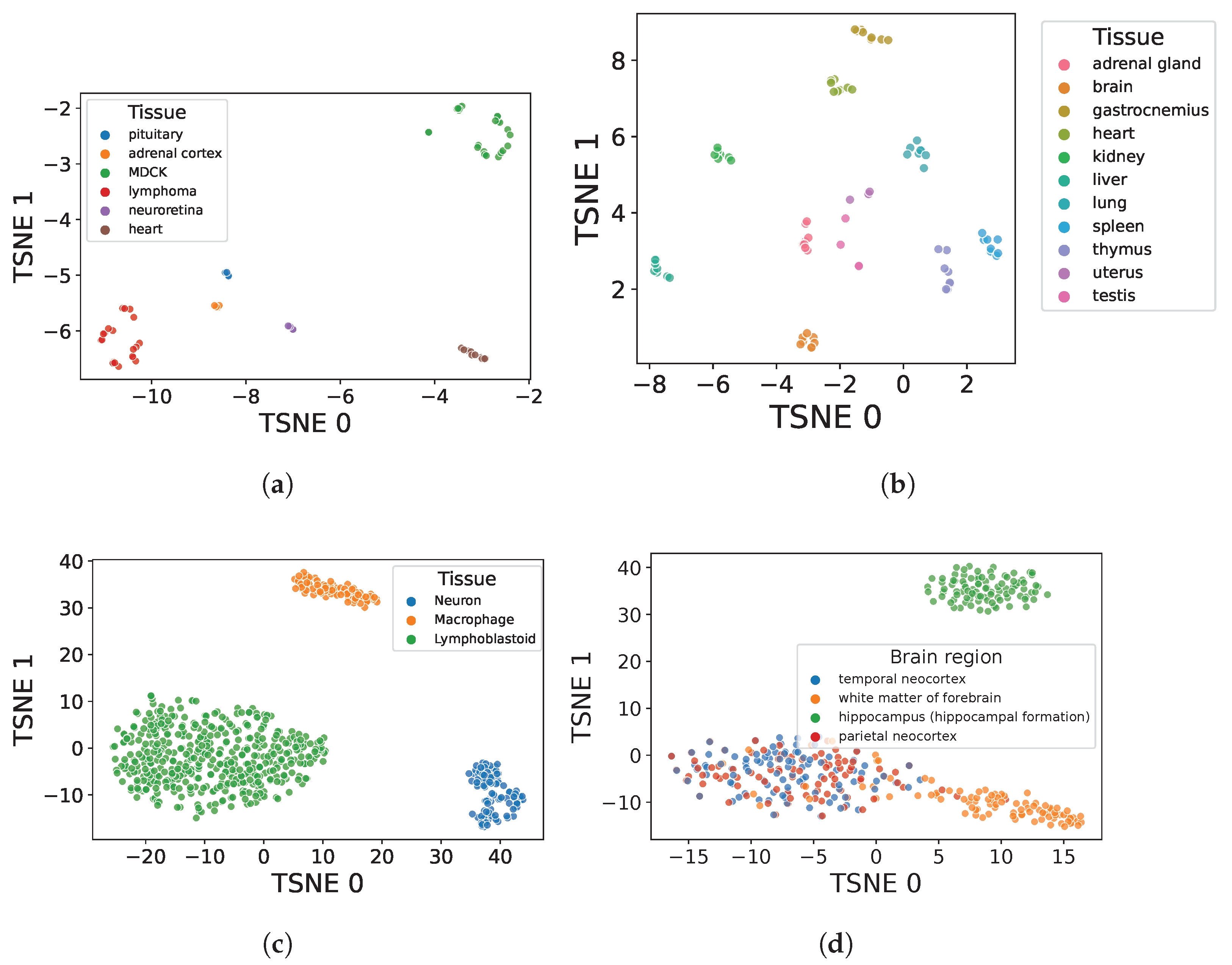
Appendix B. List of TFs from Studied Communities
| Dataset | Community | Transcription Factors |
|---|---|---|
| C. familiaris | ANKAR, ARID3C, DACH2, ENSCAFG00000023024, ENSCAFG00000032541, ESR2, FOXN4, GBX1, GBX2, GSX1, GSX2, HELT, HES5, IRX6, NHLH1, NR2E1, ONECUT2, ONECUT3, POU4F2, POU4F3, POU6F2, PRDM13, PRDM8, PRMT8, PTF1A, SALL3, SEBOX, SOX8, TCF23, TENM2, TFAP2D, VSX1, ZGLP1, ZIC4, ZNF556 | |
| R. norvegicus | AABR07042454.1, Barhl2, Bhlhe22, Ctnnd2, Fezf1, Fezf2, Figla, Foxr1, Gmeb1, Gsx1, Helt, Kcnip3, L3mbtl1, LOC100909856, Lhx9, Neurog2, Nkx6-2, Nsmce4a, Olig1, Pou3f2, Pou3f4, Pou4f2, Prmt8, Rnf14, Sp8, Tfap2d, Zfp648, Zic2 | |
| H. sapiens Control/Alzheimer | ACTR6, ALYREF, C1QBP, C6orf89, CEBPZ, CHD8, CIR1, CPEB1, DPY30, DR1, ELP2, ELP3, ESF1, FHIT, GCFC2, HEATR1, HINT1, HNRNPK, KDM8, LEO1, LRPPRC, MED30, NAA15, NCL, NFKBIB, NIF3L1, NPAT, ORC2, PA2G4, POLR3C, PREB, RBMX, SIN3A, SMARCD1, SNW1, SRA1, SUPT16H, TAF11, TAF2, TAF5L, TCEAL2, TCEAL3, TCEAL5, TDRD3, THAP5, TMF1, TOX4, TRIM24, TSG101, WDR5, XRCC6, YEATS4, ZNF112, ZNF165, ZNF18, ZNF235, ZNF302, ZNF512, ZNF75D | |
| H. sapiens Control/Alzheimer | BEND3, BTN3A3, CBL, CGGBP1, CNOT11, DAXX, EYA3, FAM208A, HELZ2, HMGA1, HMGB1, IRF7, IRF9, KDM5C, LCORL, MED27, MED31, NFYB, NMI, PARP12, PARP14, PARP9, PICALM, PNRC2, RAD21, RNF14, RNF168, SAP30L, SREBF2, SS18L2, STAT1, TBPL1, TDP2, TRIM25, WAC, WWP1, YWHAB, ZBTB14, ZBTB38, ZFX, ZNF189, ZNF230, ZNF254, ZNF285, ZNF32, ZNF420, ZNF486, ZNF525, ZNF546, ZNF569, ZNF770, ZNF813, ZNF823, ZNFX1, ZSCAN5A |
References
- Latchman, D. Gene Regulation; Taylor & Francis: Abingdon, UK, 2007. [Google Scholar]
- Sanguinetti, G.; Huynh-Thu, V.A. Gene regulatory network inference: An introductory survey. In Gene Regulatory Networks: Methods and Protocols; Springer: Cham, Switzerland, 2019; pp. 1–23. [Google Scholar]
- Aibar, S.; González-Blas, C.B.; Moerman, T.; Imrichova, H.; Hulselmans, G.; Rambow, F.; Marine, J.C.; Geurts, P.; Aerts, J.; van den Oord, J.; et al. SCENIC: Single-cell regulatory network inference and clustering. Nat. Methods 2017, 14, 1083. [Google Scholar]
- Jagtap, S.; Pirayre, A.; Bidard, F.; Duval, L.; Malliaros, F.D. BRANEnet: Embedding Multilayer Networks for Omics Data Integration. BMC Bioinform. 2022, 23, 429. [Google Scholar]
- Tan, A.K.; Mohamad, M.S. Using Bayesian networks to construct gene regulatory networks from microarray data. J. Teknol. 2012, 58, 1–6. [Google Scholar]
- Chai, L.E.; Loh, S.K.; Low, S.T.; Mohamad, M.S.; Deris, S.; Zakaria, Z. A review on the computational approaches for gene regulatory network construction. Comput. Biol. Med. 2014, 48, 55–65. [Google Scholar]
- Zhang, B.; Horvath, S. A general framework for weighted gene co-expression network analysis. Stat. Appl. Genet. Mol. Biol. 2005, 4, 1–43. [Google Scholar]
- Faith, J.J.; Hayete, B.; Thaden, J.T.; Mogno, I.; Wierzbowski, J.; Cottarel, G.; Kasif, S.; Collins, J.J.; Gardner, T.S. Large-scale mapping and validation of Escherichia coli transcriptional regulation from a compendium of expression profiles. PLoS Biol. 2007, 5, e8. [Google Scholar]
- Irrthum, A.; Wehenkel, L.; Geurts, P. Inferring regulatory networks from expression data using tree-based methods. PLoS ONE 2010, 5, e12776. [Google Scholar]
- Haury, A.C.; Mordelet, F.; Vera-Licona, P.; Vert, J.P. TIGRESS: Trustful inference of gene regulation using stability selection. BMC Syst. Biol. 2012, 6, 145. [Google Scholar]
- Peignier, S.; Schmitt, P.; Calevro, F. Data-driven Gene Regulatory Network Inference based on Classification Algorithms. In Proceedings of the 2019 IEEE International Conference on Tools with Artificial Intelligence (ICTAI), Portland, OR, USA, 4–6 November 2019; pp. 1–8. [Google Scholar]
- Bishop, C.M. Pattern Recognition and Machine Learning (Information Science and Statistics); Springer: Berlin/Heidelberg, Germany, 2006. [Google Scholar]
- Everitt, B. The Cambridge Dictionary of Statistics; Cambridge University Press: Cambridge, UK; New York, NY, USA, 2002. [Google Scholar]
- Anderson, D.; Burnham, K. Model Selection and Multi-Model Inference, 2nd ed.; Springer: New York, NY, USA, 2004; Volume 63, p. 10. [Google Scholar]
- Freedman, D.A.; Freedman, D.A. A note on screening regression equations. Am. Stat. 1983, 37, 152–155. [Google Scholar]
- López, J.; Maldonado, S.; Carrasco, M. Double regularization methods for robust feature selection and SVM classification via DC programming. Inf. Sci. 2018, 429, 377–389. [Google Scholar]
- Cawley, G.C.; Talbot, N.L. Gene selection in cancer classification using sparse logistic regression with Bayesian regularization. Bioinformatics 2006, 22, 2348–2355. [Google Scholar]
- Yao, Y.; Rosasco, L.; Caponnetto, A. On early stopping in gradient descent learning. Constr. Approx. 2007, 26, 289–315. [Google Scholar]
- Khan, S.H.; Hayat, M.; Porikli, F. Regularization of deep neural networks with spectral dropout. Neural Netw. 2019, 110, 82–90. [Google Scholar] [PubMed]
- Esposito, F.; Malerba, D.; Semeraro, G.; Kay, J. A comparative analysis of methods for pruning decision trees. IEEE Trans. Pattern Anal. Mach. Intell. 1997, 19, 476–491. [Google Scholar]
- Kohavi, R. A study of cross-validation and bootstrap for accuracy estimation and model selection. In Proceedings of the IJCAI, Montreal, BC, Canada, 20–25 August 1995; Volume 14, pp. 1137–1145. [Google Scholar]
- Peignier, S.; Schmitt, P.; Calevro, F. Data-driven Gene Regulatory Networks Inference Based on Classification Algorithms. Int. J. Artif. Intell. Tools 2021, 30, 2150022. [Google Scholar]
- Peignier, S.; Sorin, B.; Calevro, F. Ensemble Learning Based Gene Regulatory Network Inference. In Proceedings of the 2021 IEEE 33rd International Conference on Tools with Artificial Intelligence (ICTAI), Washington, DC, USA, 1–3 November 2021; pp. 113–120. [Google Scholar]
- Marbach, D.; Costello, J.C.; Küffner, R.; Vega, N.M.; Prill, R.J.; Camacho, D.M.; Allison, K.R.; Consortium, D.; Kellis, M.; Collins, J.J.; et al. Wisdom of crowds for robust gene network inference. Nat. Methods 2012, 9, 796. [Google Scholar]
- Elhamifar, E.; Vidal, R. Sparse subspace clustering: Algorithm, theory, and applications. IEEE Trans. Pattern Anal. Mach. Intell. 2013, 35, 2765–2781. [Google Scholar]
- Hong, W.; Wright, J.; Huang, K.; Ma, Y. Multiscale hybrid linear models for lossy image representation. IEEE Trans. Image Process. 2006, 15, 3655–3671. [Google Scholar]
- Yang, A.Y.; Wright, J.; Ma, Y.; Sastry, S.S. Unsupervised segmentation of natural images via lossy data compression. Comput. Vis. Image Underst. 2008, 110, 212–225. [Google Scholar]
- Vidal, R.; Ma, Y.; Sastry, S. Generalized principal component analysis (GPCA). IEEE Trans. Pattern Anal. Mach. Intell. 2005, 27, 1945–1959. [Google Scholar] [PubMed]
- Kanatani, K.i. Motion segmentation by subspace separation and model selection. In Proceedings of the 8th IEEE International Conference on Computer Vision. ICCV 2001, Vancouver, BC, Canada, 7–14 July 2001; Volume 2, pp. 586–591. [Google Scholar]
- Hashemi, A.; Vikalo, H. Evolutionary Subspace Clustering: Discovering Structure in Self-expressive Time-series Data. In Proceedings of the 2019 IEEE International Conference on Acoustics, Speech and Signal Processing (ICASSP), Brighton, UK, 12–17 May 2019; pp. 3707–3711. [Google Scholar]
- You, C.; Li, C.G.; Robinson, D.P.; Vidal, R. Oracle based active set algorithm for scalable elastic net subspace clustering. In Proceedings of the IEEE Conference on Computer Vision and Pattern Recognition, Las Vegas, NV, USA, 26 June–1 July2016; pp. 3928–3937. [Google Scholar]
- Zheng, X.; Aragam, B.; Ravikumar, P.K.; Xing, E.P. DAGs with NO TEARS: Continuous Optimization for Structure Learning. Adv. Neural Inf. Process. Syst. 2018, 31, 9492–9503. [Google Scholar]
- Yu, Y.; Chen, J.; Gao, T.; Yu, M. Dag-gnn: Dag structure learning with graph neural networks. In Proceedings of the International Conference on Machine Learning, PMLR, Long Beach, CA, USA, 9–15 June 2019; pp. 7154–7163. [Google Scholar]
- Zhu, S.; Ng, I.; Chen, Z. Causal Discovery with Reinforcement Learning. In Proceedings of the International Conference on Learning Representations, New Orleans, LA, USA, 6–9 May 2019. [Google Scholar]
- Gencoglu, O.; Gruber, M. Causal modeling of twitter activity during COVID-19. Computation 2020, 8, 85. [Google Scholar] [CrossRef]
- Friedman, J.; Hastie, T.; Tibshirani, R. Regularization paths for generalized linear models via coordinate descent. J. Stat. Softw. 2010, 33, 1. [Google Scholar] [CrossRef]
- Mallat, S.G.; Zhang, Z. Matching pursuits with time-frequency dictionaries. IEEE Trans. Signal Process. 1993, 41, 3397–3415. [Google Scholar] [CrossRef]
- You, C.; Robinson, D.; Vidal, R. Scalable sparse subspace clustering by orthogonal matching pursuit. In Proceedings of the IEEE Conference on Computer Vision and Pattern Recognition, Las Vegas, NV, USA, June 26 – July 1 2016; pp. 3918–3927. [Google Scholar]
- Dyer, E.L.; Sankaranarayanan, A.C.; Baraniuk, R.G. Greedy feature selection for subspace clustering. J. Mach. Learn. Res. 2013, 14, 2487–2517. [Google Scholar]
- Vidal, R.; Favaro, P. Low rank subspace clustering (LRSC). Pattern Recognit. Lett. 2014, 43, 47–61. [Google Scholar] [CrossRef]
- Stone, M. Cross-validatory choice and assessment of statistical predictions. J. R. Stat. Soc. Ser. B 1974, 36, 111–133. [Google Scholar] [CrossRef]
- Cawley, G.C.; Talbot, N.L. On over-fitting in model selection and subsequent selection bias in performance evaluation. J. Mach. Learn. Res. 2010, 11, 2079–2107. [Google Scholar]
- Moerman, T.; Aibar Santos, S.; Bravo González-Blas, C.; Simm, J.; Moreau, Y.; Aerts, J.; Aerts, S. GRNBoost2 and Arboreto: Efficient and scalable inference of gene regulatory networks. Bioinformatics 2019, 35, 2159–2161. [Google Scholar] [CrossRef]
- Gama-Castro, S.; Salgado, H.; Peralta-Gil, M.; Santos-Zavaleta, A.; Muniz-Rascado, L.; Solano-Lira, H.; Jimenez-Jacinto, V.; Weiss, V.; Garcia-Sotelo, J.S.; Lopez-Fuentes, A.; et al. RegulonDB version 7.0: Transcriptional regulation of Escherichia coli K-12 integrated within genetic sensory response units (Gensor Units). Nucleic Acids Res. 2010, 39, D98–D105. [Google Scholar] [CrossRef]
- Zhu, C.; Byers, K.J.; McCord, R.P.; Shi, Z.; Berger, M.F.; Newburger, D.E.; Saulrieta, K.; Smith, Z.; Shah, M.V.; Radhakrishnan, M.; et al. High-resolution DNA-binding specificity analysis of yeast transcription factors. Genome Res. 2009, 19, 556–566. [Google Scholar] [CrossRef]
- MacIsaac, K.D.; Wang, T.; Gordon, D.B.; Gifford, D.K.; Stormo, G.D.; Fraenkel, E. An improved map of conserved regulatory sites for Saccharomyces cerevisiae. BMC Bioinform. 2006, 7, 113. [Google Scholar] [CrossRef]
- Novichkov, P.S.; Laikova, O.N.; Novichkova, E.S.; Gelfand, M.S.; Arkin, A.P.; Dubchak, I.; Rodionov, D.A. RegPrecise: A database of curated genomic inferences of transcriptional regulatory interactions in prokaryotes. Nucleic Acids Res. 2009, 38, D111–D118. [Google Scholar] [CrossRef]
- Schaffter, T.; Marbach, D.; Floreano, D. GeneNetWeaver: In silico benchmark generation and performance profiling of network inference methods. Bioinformatics 2011, 27, 2263–2270. [Google Scholar] [CrossRef]
- Marbach, D.; Prill, R.J.; Schaffter, T.; Mattiussi, C.; Floreano, D.; Stolovitzky, G. Revealing strengths and weaknesses of methods for gene network inference. Proc. Natl. Acad. Sci. USA 2010, 107, 6286–6291. [Google Scholar] [CrossRef] [PubMed]
- Howe, K.L.; Achuthan, P.; Allen, J.; Allen, J.; Alvarez-Jarreta, J.; Amode, M.R.; Armean, I.M.; Azov, A.G.; Bennett, R.; Bhai, J.; et al. Ensembl 2021. Nucleic Acids Res. 2021, 49, D884–D891. [Google Scholar] [CrossRef] [PubMed]
- Hu, H.; Miao, Y.R.; Jia, L.H.; Yu, Q.Y.; Zhang, Q.; Guo, A.Y. AnimalTFDB 3.0: A comprehensive resource for annotation and prediction of animal transcription factors. Nucleic Acids Res. 2019, 47, D33–D38. [Google Scholar] [CrossRef]
- Tang, B.; Zhou, Q.; Dong, L.; Li, W.; Zhang, X.; Lan, L.; Zhai, S.; Xiao, J.; Zhang, Z.; Bao, Y.; et al. iDog: An integrated resource for domestic dogs and wild canids. Nucleic Acids Res. 2019, 47, D793–D800. [Google Scholar] [CrossRef]
- Yu, Y.; Fuscoe, J.C.; Zhao, C.; Guo, C.; Jia, M.; Qing, T.; Bannon, D.I.; Lancashire, L.; Bao, W.; Du, T.; et al. A rat RNA-Seq transcriptomic BodyMap across 11 organs and 4 developmental stages. Nat. Commun. 2014, 5, 3230. [Google Scholar] [CrossRef]
- Alasoo, K. Regulation of Gene Expression in Macrophage Immune Response. Ph.D. Thesis, University of Cambridge, Cambridge, UK, 2017. [Google Scholar]
- Schwartzentruber, J.; Foskolou, S.; Kilpinen, H.; Rodrigues, J.; Alasoo, K.; Knights, A.J.; Patel, M.; Goncalves, A.; Ferreira, R.; Benn, C.L.; et al. Molecular and functional variation in iPSC-derived sensory neurons. Nat. Genet. 2018, 50, 54–61. [Google Scholar] [CrossRef] [PubMed]
- Ferreira, P.G.; Oti, M.; Barann, M.; Wieland, T.; Ezquina, S.; Friedländer, M.R.; Rivas, M.A.; Esteve-Codina, A.; Rosenstiel, P.; Strom, T.M.; et al. Sequence variation between 462 human individuals fine-tunes functional sites of RNA processing. Sci. Rep. 2016, 6, 32406. [Google Scholar] [CrossRef]
- Papatheodorou, I.; Fonseca, N.A.; Keays, M.; Tang, Y.A.; Barrera, E.; Bazant, W.; Burke, M.; Füllgrabe, A.; Fuentes, A.M.P.; George, N.; et al. Expression Atlas: Gene and protein expression across multiple studies and organisms. Nucleic Acids Res. 2018, 46, D246–D251. [Google Scholar] [CrossRef]
- Nygaard, V.; Rødland, E.A.; Hovig, E. Methods that remove batch effects while retaining group differences may lead to exaggerated confidence in downstream analyses. Biostatistics 2016, 17, 29–39. [Google Scholar] [CrossRef]
- Allen Institute for Brain Science. Aging, Dementia and TBI. Available online: https://aging.brain-map.org/download/index. (accessed on 15 February 2023).
- Miller, J.A.; Guillozet-Bongaarts, A.; Gibbons, L.E.; Postupna, N.; Renz, A.; Beller, A.E.; Sunkin, S.M.; Ng, L.; Rose, S.E.; Smith, K.A.; et al. Neuropathological and transcriptomic characteristics of the aged brain. Elife 2017, 6, e31126. [Google Scholar] [CrossRef] [PubMed]
- Fawcett, T. An introduction to ROC analysis. Pattern Recognit. Lett. 2006, 27, 861–874. [Google Scholar] [CrossRef]
- Davis, J.; Goadrich, M. The relationship between Precision-Recall and ROC curves. In Proceedings of the 23rd International Conference on Machine Learning, Pittsburgh, PA, USA, 25–29 June 2006; pp. 233–240. [Google Scholar]
- Lewis-Beck, C.; Lewis-Beck, M. Applied Regression: An Introduction; Sage Publications: Thousand Oaks, CA, USA, 2015; Volume 22. [Google Scholar]
- Clauset, A.; Newman, M.E.; Moore, C. Finding community structure in very large networks. Phys. Rev. E 2004, 70, 066111. [Google Scholar] [CrossRef]
- Leicht, E.A.; Newman, M.E. Community structure in directed networks. Phys. Rev. Lett. 2008, 100, 118703. [Google Scholar] [CrossRef]
- Satopaa, V.; Albrecht, J.; Irwin, D.; Raghavan, B. Finding a “kneedle” in a haystack: Detecting knee points in system behavior. In Proceedings of the 2011 31st International Conference on Distributed Computing Systems Workshops, Minneapolis, MI, USA, 20–24 June 2011; pp. 166–171. [Google Scholar]
- Subramanian, A.; Tamayo, P.; Mootha, V.K.; Mukherjee, S.; Ebert, B.L.; Gillette, M.A.; Paulovich, A.; Pomeroy, S.L.; Golub, T.R.; Lander, E.S.; et al. Gene set enrichment analysis: A knowledge-based approach for interpreting genome-wide expression profiles. Proc. Natl. Acad. Sci. USA 2005, 102, 15545–15550. [Google Scholar] [CrossRef] [PubMed]
- Klopfenstein, D.; Zhang, L.; Pedersen, B.S.; Ramírez, F.; Warwick Vesztrocy, A.; Naldi, A.; Mungall, C.J.; Yunes, J.M.; Botvinnik, O.; Weigel, M.; et al. GOATOOLS: A Python library for Gene Ontology analyses. Sci. Rep. 2018, 8, 1–17. [Google Scholar] [CrossRef]
- Schmitt, P.; Sorin, B.; Frouté, T.; Parisot, N.; Calevro, F.; Peignier, S. GReNaDIne: A Data-Driven Python Library to Infer Gene Regulatory Networks from Gene Expression Data. Genes 2023, 14, 269. [Google Scholar] [CrossRef]
- Pedregosa, F.; Varoquaux, G.; Gramfort, A.; Michel, V.; Thirion, B.; Grisel, O.; Blondel, M.; Prettenhofer, P.; Weiss, R.; Dubourg, V.; et al. Scikit-learn: Machine learning in Python. J. Mach. Learn. Res. 2011, 12, 2825–2830. [Google Scholar]
- Zhou, H.; Yoshioka, T.; Nathans, J. Retina-derived POU-domain factor-1: A complex POU-domain gene implicated in the development of retinal ganglion and amacrine cells. J. Neurosci. 1996, 16, 2261–2274. [Google Scholar] [CrossRef] [PubMed]
- Watanabe, S.; Sanuki, R.; Sugita, Y.; Imai, W.; Yamazaki, R.; Kozuka, T.; Ohsuga, M.; Furukawa, T. Prdm13 regulates subtype specification of retinal amacrine interneurons and modulates visual sensitivity. J. Neurosci. 2015, 35, 8004–8020. [Google Scholar] [CrossRef]
- Eckler, M.J.; Chen, B. Fez family transcription factors: Controlling neurogenesis and cell fate in the developing mammalian nervous system. BioEssays 2014, 36, 788–797. [Google Scholar] [CrossRef]
- Chouchane, M.; Costa, M.R. Instructing neuronal identity during CNS development and astroglial-lineage reprogramming: Roles of NEUROG2 and ASCL1. Brain Res. 2019, 1705, 66–74. [Google Scholar] [CrossRef]
- Hashizume, K.; Yamanaka, M.; Ueda, S. POU3F2 participates in cognitive function and adult hippocampal neurogenesis via mammalian-characteristic amino acid repeats. Genes Brain Behav. 2018, 17, 118–125. [Google Scholar] [CrossRef]
- McDermaid, A.; Monier, B.; Zhao, J.; Liu, B.; Ma, Q. Interpretation of differential gene expression results of RNA-seq data: Review and integration. Briefings Bioinform. 2019, 20, 2044–2054. [Google Scholar] [CrossRef]
- Crooke, P.S., III; Tossberg, J.T.; Heinrich, R.M.; Porter, K.P.; Aune, T.M. Reduced RNA adenosine-to-inosine editing in hippocampus vasculature associated with Alzheimer’s disease. Brain Commun. 2022, 4, fcac238. [Google Scholar] [CrossRef] [PubMed]
- Wu, A.T.; Lawal, B.; Wei, L.; Wen, Y.T.; Tzeng, D.T.; Lo, W.C. Multiomics identification of potential targets for Alzheimer disease and antrocin as a therapeutic candidate. Pharmaceutics 2021, 13, 1555. [Google Scholar] [CrossRef]
- Hallock, P.; Thomas, M.A. Integrating the Alzheimer’s disease proteome and transcriptome: A comprehensive network model of a complex disease. Omics 2012, 16, 37–49. [Google Scholar] [CrossRef] [PubMed]
- Wang, H.; Han, X.; Gao, S. Identification of potential biomarkers for pathogenesis of Alzheimer’s disease. Hereditas 2021, 158, 1–8. [Google Scholar] [CrossRef] [PubMed]
- Siangphoe, U.; Archer, K.J. Gene expression in HIV-associated neurocognitive disorders: A meta-analysis. JAIDS J. Acquir. Immune Defic. Syndr. 2015, 70, 479–488. [Google Scholar] [CrossRef] [PubMed]
- Yu, Y.; Fedele, G.; Celardo, I.; Loh, S.H.; Martins, L.M. Parp mutations protect from mitochondrial toxicity in Alzheimer’s disease. Cell Death Dis. 2021, 12, 651. [Google Scholar] [CrossRef]
- Sidhu, R.; Gatt, A.; Fratta, P.; Lashley, T.; Bampton, A. HnRNP K mislocalisation in neurons of the dentate nucleus is a novel neuropathological feature of neurodegenerative disease and ageing. Neuropathol. Appl. Neurobiol. 2022, 48, e12793. [Google Scholar] [CrossRef] [PubMed]
- Feng, B.; Hu, P.; Chen, J.; Liu, Q.; Li, X.; Du, Y. Analysis of Differentially Expressed Genes Associated With Alzheimer’s Disease Based on Bioinformatics Methods. Am. J. Alzheimer’S Dis. Other Dementias 2015, 30, 746–751. [Google Scholar] [CrossRef]
- Xiao, G.; Chen, Q.; Zhang, X. MicroRNA-455–5p/CPEB1 pathway mediates Aβ-related learning and memory deficits in a mouse model of Alzheimer’s disease. Brain Res. Bull. 2021, 177, 282–294. [Google Scholar] [CrossRef]
- Kitamura, Y.; Shimohama, S.; Ota, T.; Matsuoka, Y.; Nomura, Y.; Taniguchi, T. Alteration of transcription factors NF-κB and STAT1 in Alzheimer’s disease brains. Neurosci. Lett. 1997, 237, 17–20. [Google Scholar] [CrossRef]
- Garcia-Esparcia, P.; Sideris-Lampretsas, G.; Hernandez-Ortega, K.; Grau-Rivera, O.; Sklaviadis, T.; Gelpi, E.; Ferrer, I. Altered mechanisms of protein synthesis in frontal cortex in Alzheimer disease and a mouse model. Am. J. Neurodegener. Dis. 2017, 6, 15. [Google Scholar]
- Besli, N.; Sarikamis, B.; Cakmak, R.K.; Kilic, U. Exosomal circRNA-miRNA Expression Profile from Plasma in Alzheimer’s Disease Patients by Bioinformatics and Integrative Analysis; University of Health Sciences Turkey: Istanbul, Turkey, 2022. [Google Scholar]
- Hickman, S.; Izzy, S.; Sen, P.; Morsett, L.; El Khoury, J. Microglia in neurodegeneration. Nat. Neurosci. 2018, 21, 1359–1369. [Google Scholar] [CrossRef]
- Roca-Agujetas, V.; de Dios, C.; Abadin, X.; Colell, A. Upregulation of brain cholesterol levels inhibits mitophagy in Alzheimer disease. Autophagy 2021, 17, 1555–1557. [Google Scholar] [CrossRef]
- Roy, E.R.; Wang, B.; Wan, Y.w.; Chiu, G.; Cole, A.; Yin, Z.; Propson, N.E.; Xu, Y.; Jankowsky, J.L.; Liu, Z.; et al. Type I interferon response drives neuroinflammation and synapse loss in Alzheimer disease. J. Clin. Investig. 2020, 130, 1912–1930. [Google Scholar] [CrossRef]
- Noori, A.; Mezlini, A.M.; Hyman, B.T.; Serrano-Pozo, A.; Das, S. Systematic review and meta-analysis of human transcriptomics reveals neuroinflammation, deficient energy metabolism, and proteostasis failure across neurodegeneration. Neurobiol. Dis. 2021, 149, 105225. [Google Scholar] [CrossRef]
- Lloyd, S.E.; Mead, S.; Collinge, J. Genetics of prion diseases. Curr. Opin. Genet. Dev. 2013, 23, 345–351. [Google Scholar] [CrossRef] [PubMed]
- Chiricosta, L.; Gugliandolo, A.; Mazzon, E. SARS-CoV-2 exacerbates beta-amyloid neurotoxicity, inflammation and oxidative stress in Alzheimer’s disease patients. Int. J. Mol. Sci. 2021, 22, 13603. [Google Scholar] [CrossRef]
- Xu, W.; Tan, L.; Yu, J.T. The role of PICALM in Alzheimer’s disease. Mol. Neurobiol. 2015, 52, 399–413. [Google Scholar] [CrossRef] [PubMed]
- Haque, A.; Engel, J.; Teichmann, S.A.; Lönnberg, T. A practical guide to single-cell RNA-sequencing for biomedical research and clinical applications. Genome Med. 2017, 9, 1–12. [Google Scholar] [CrossRef] [PubMed]
- Van der Maaten, L.; Hinton, G. Visualizing data using t-SNE. J. Mach. Learn. Res. 2008, 9, 2579–2605. [Google Scholar]
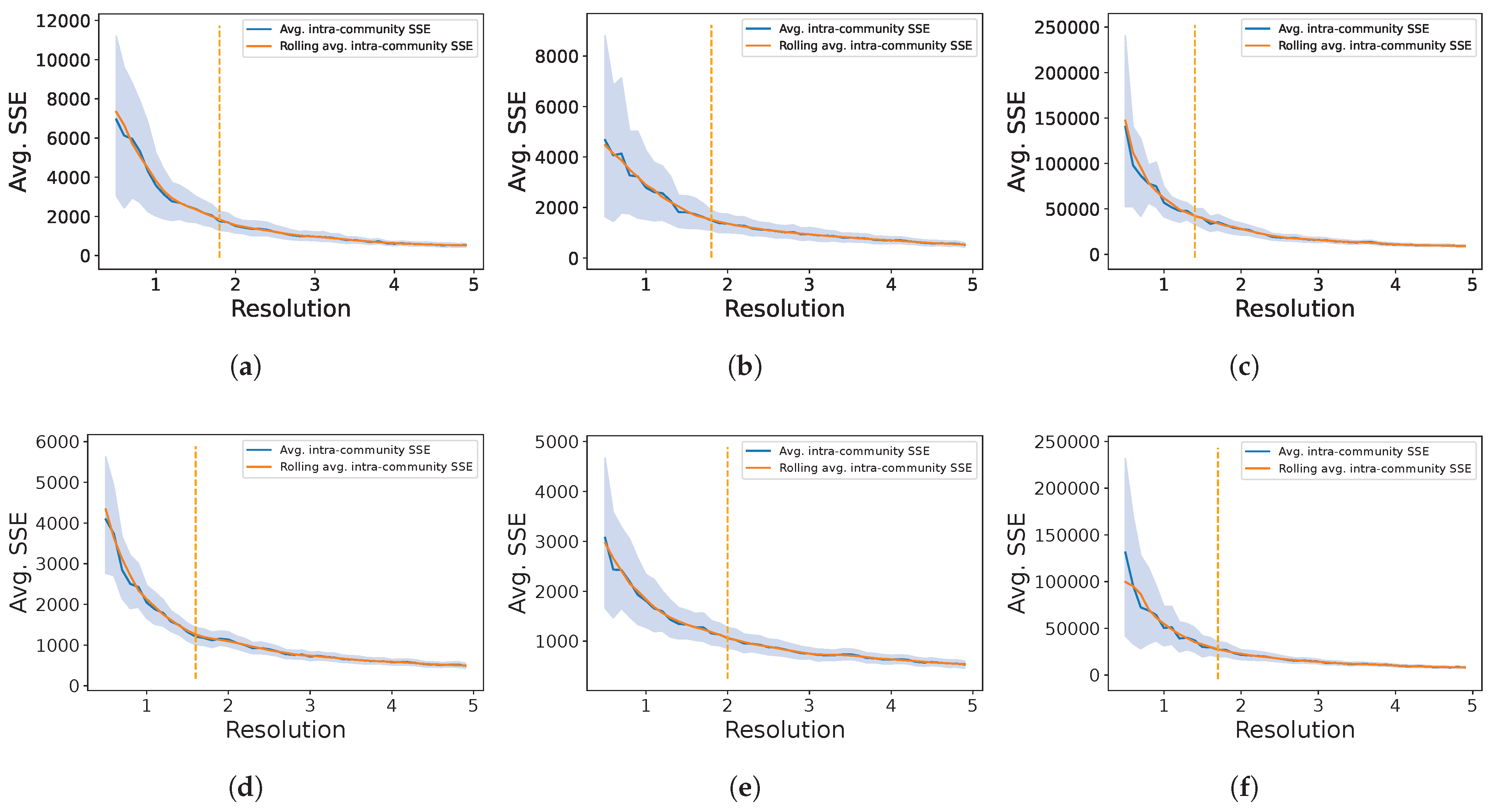
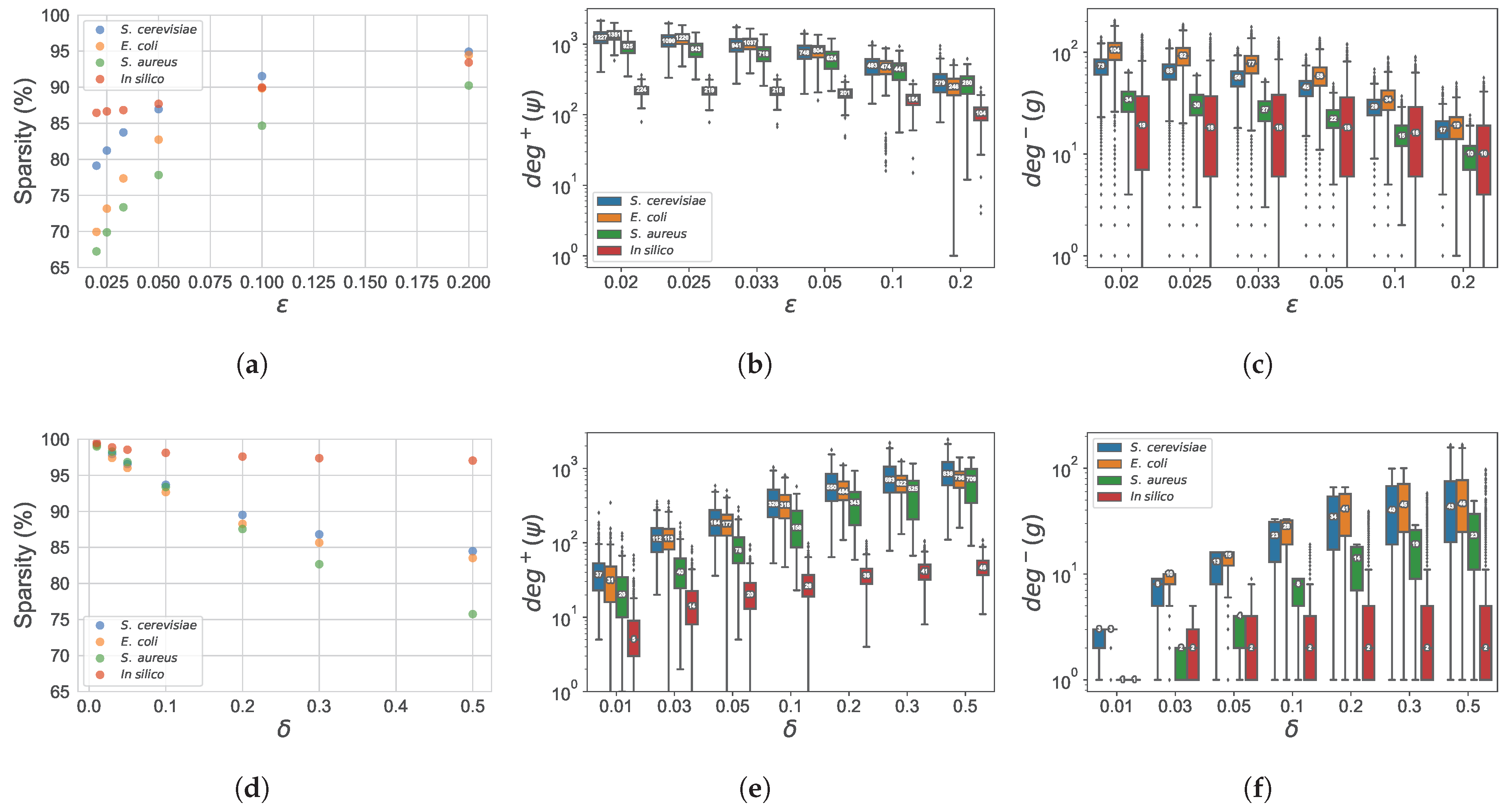
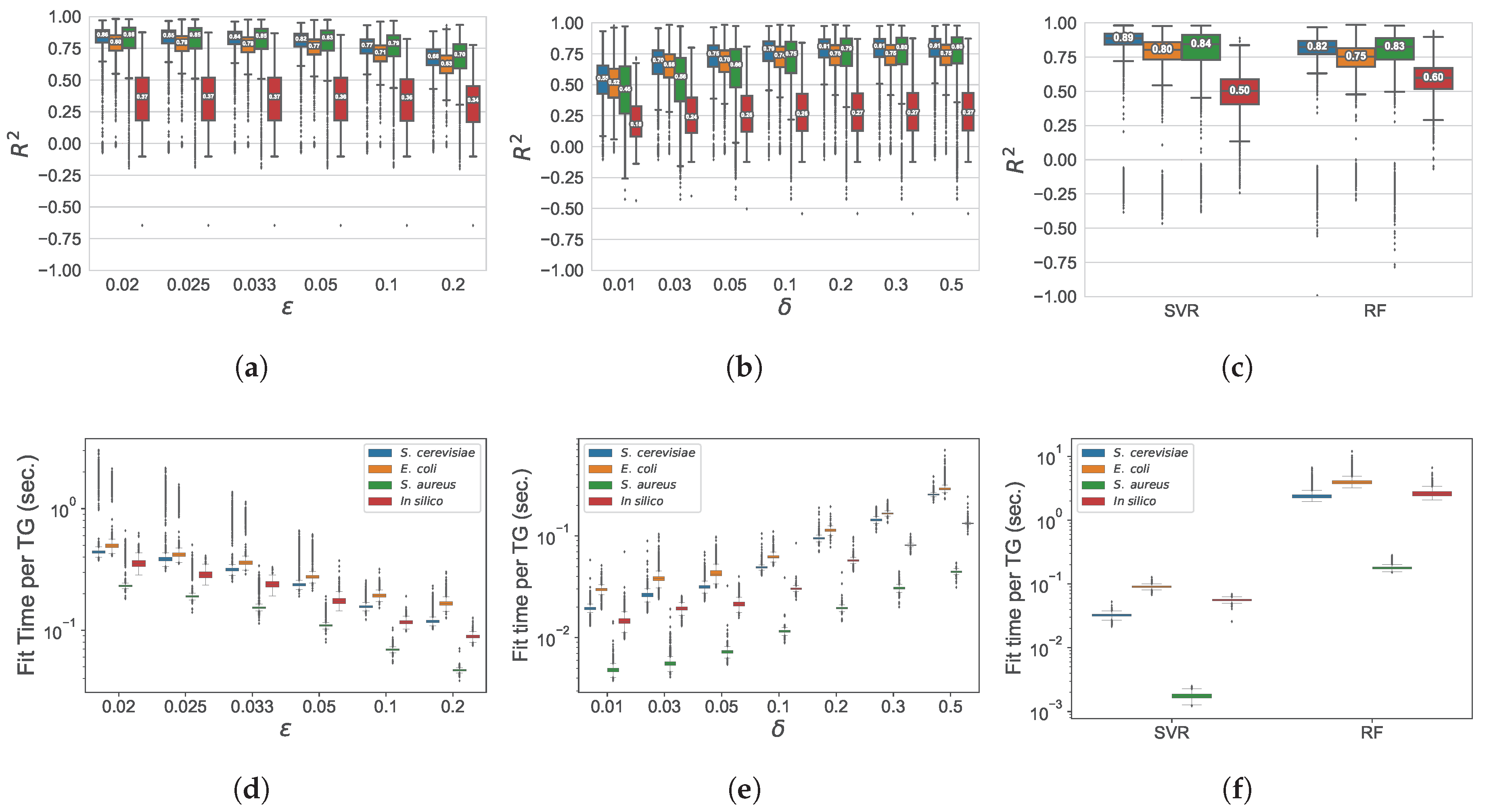
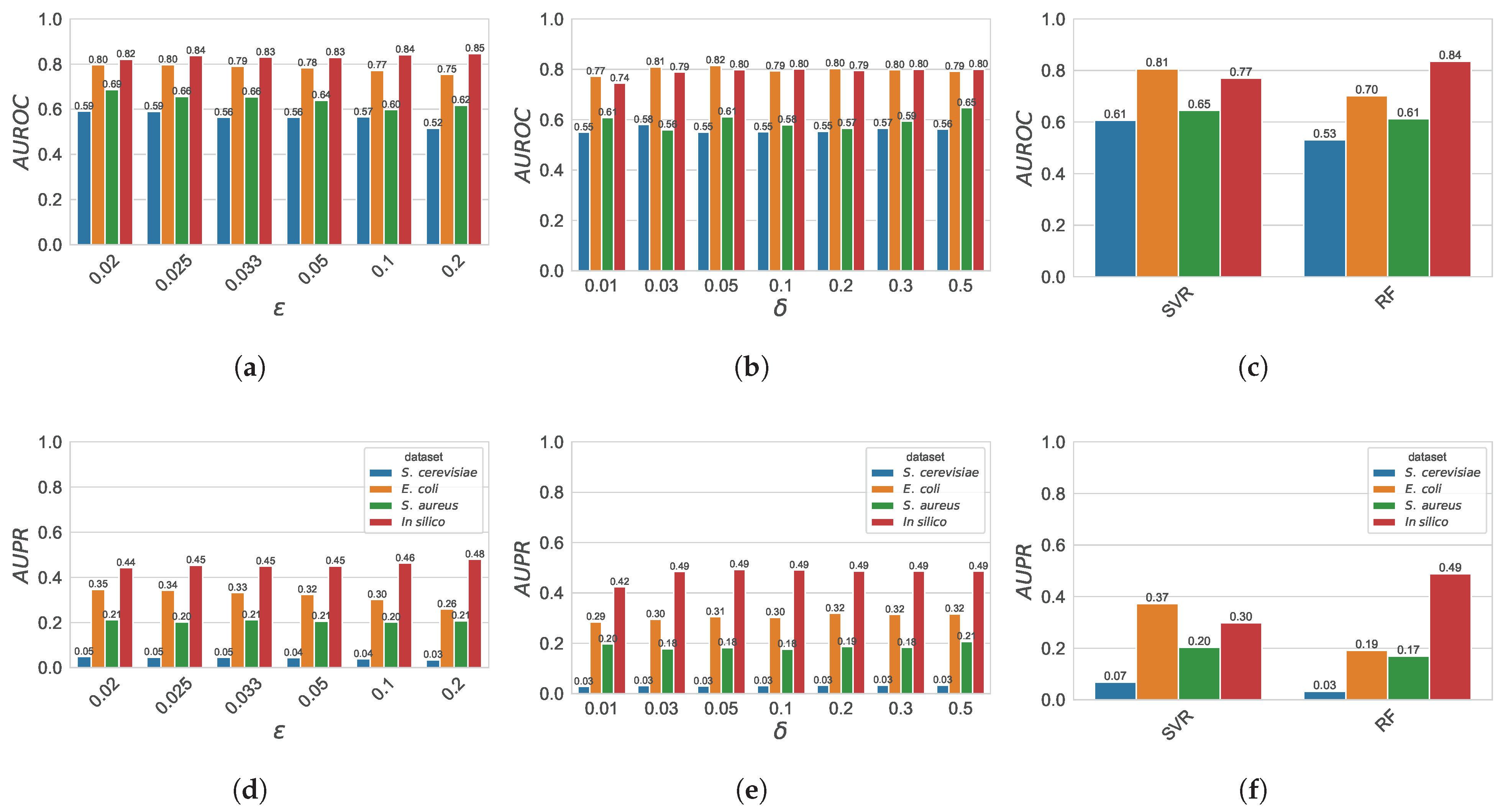

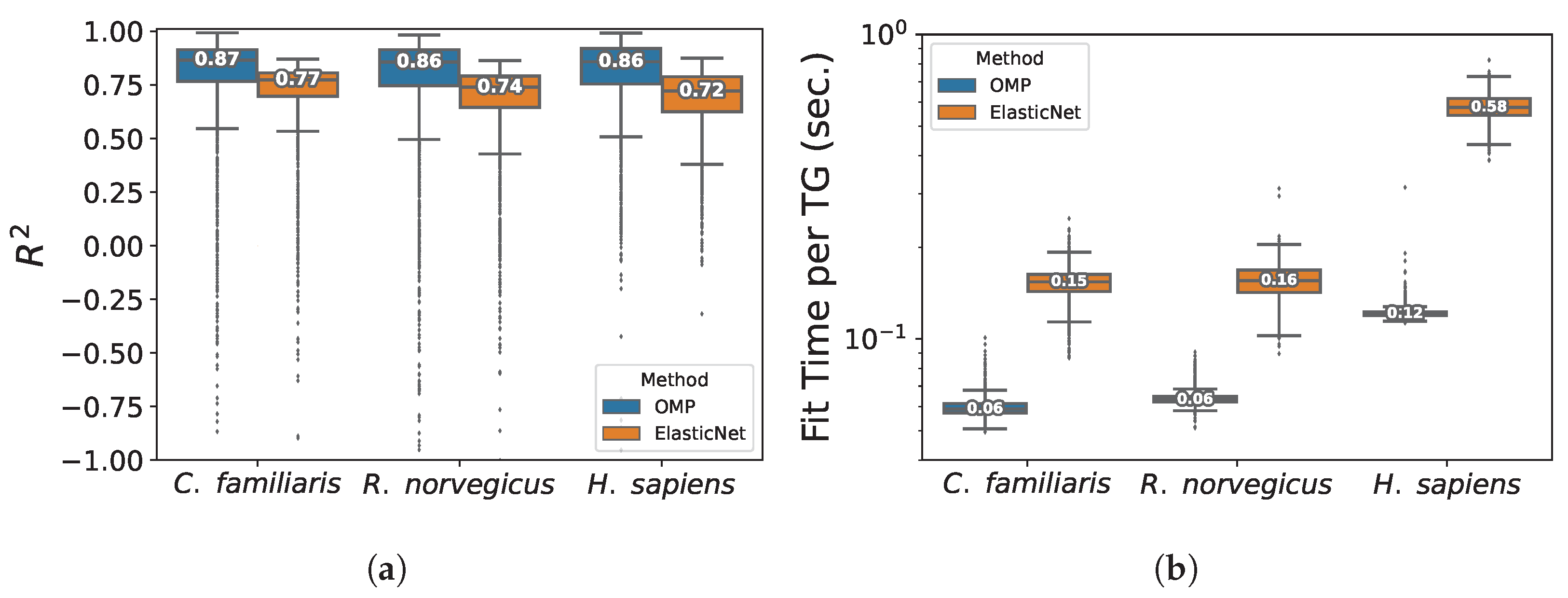
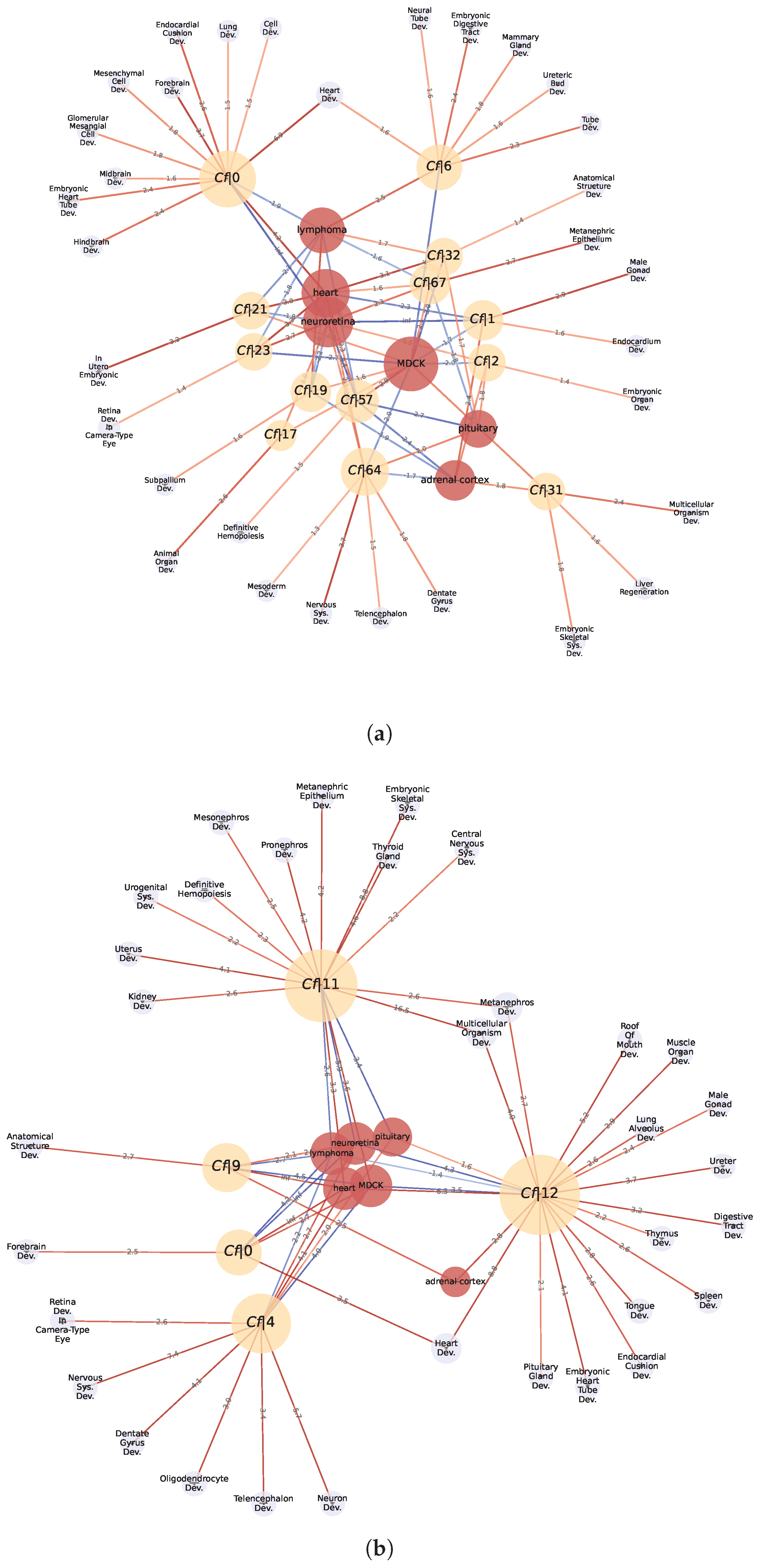
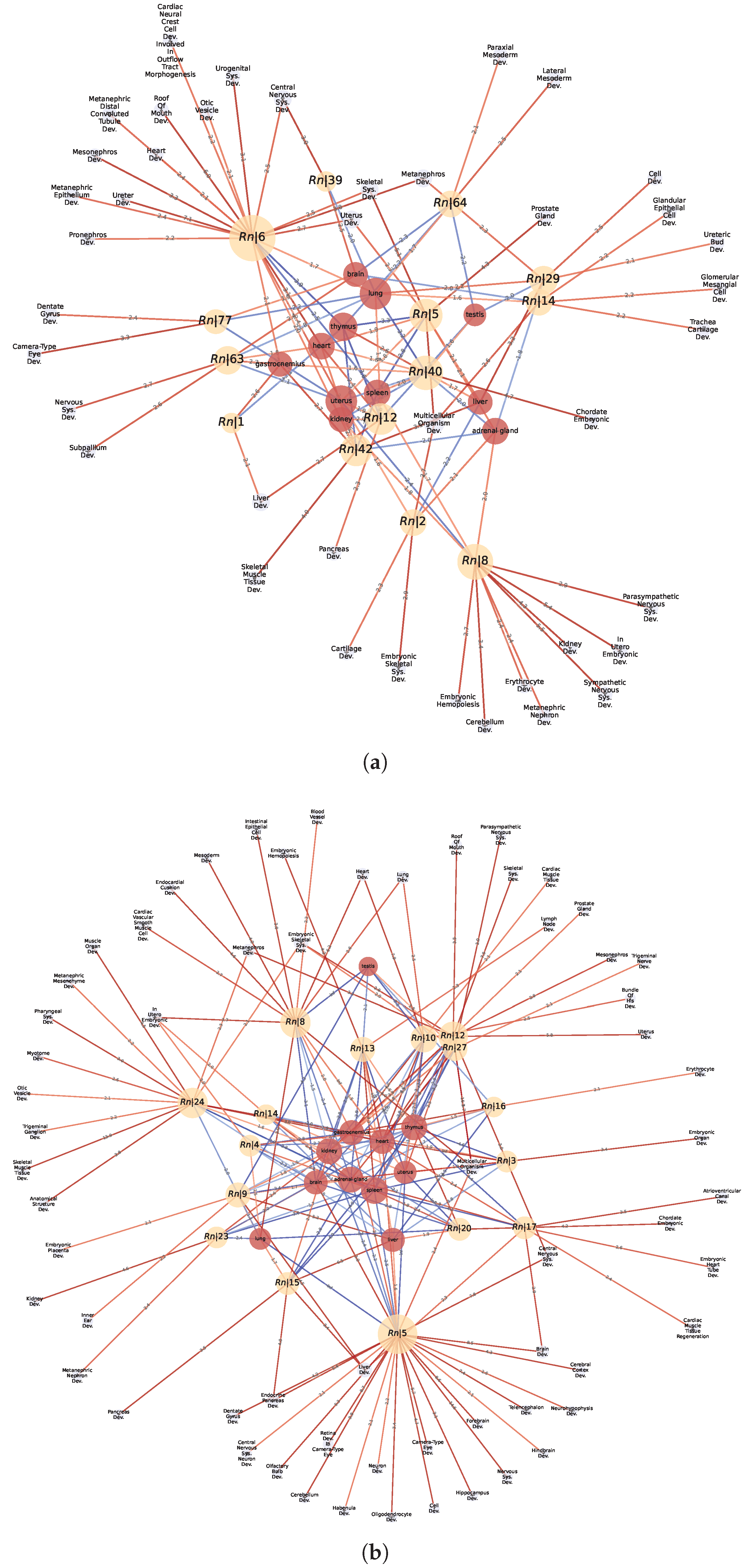
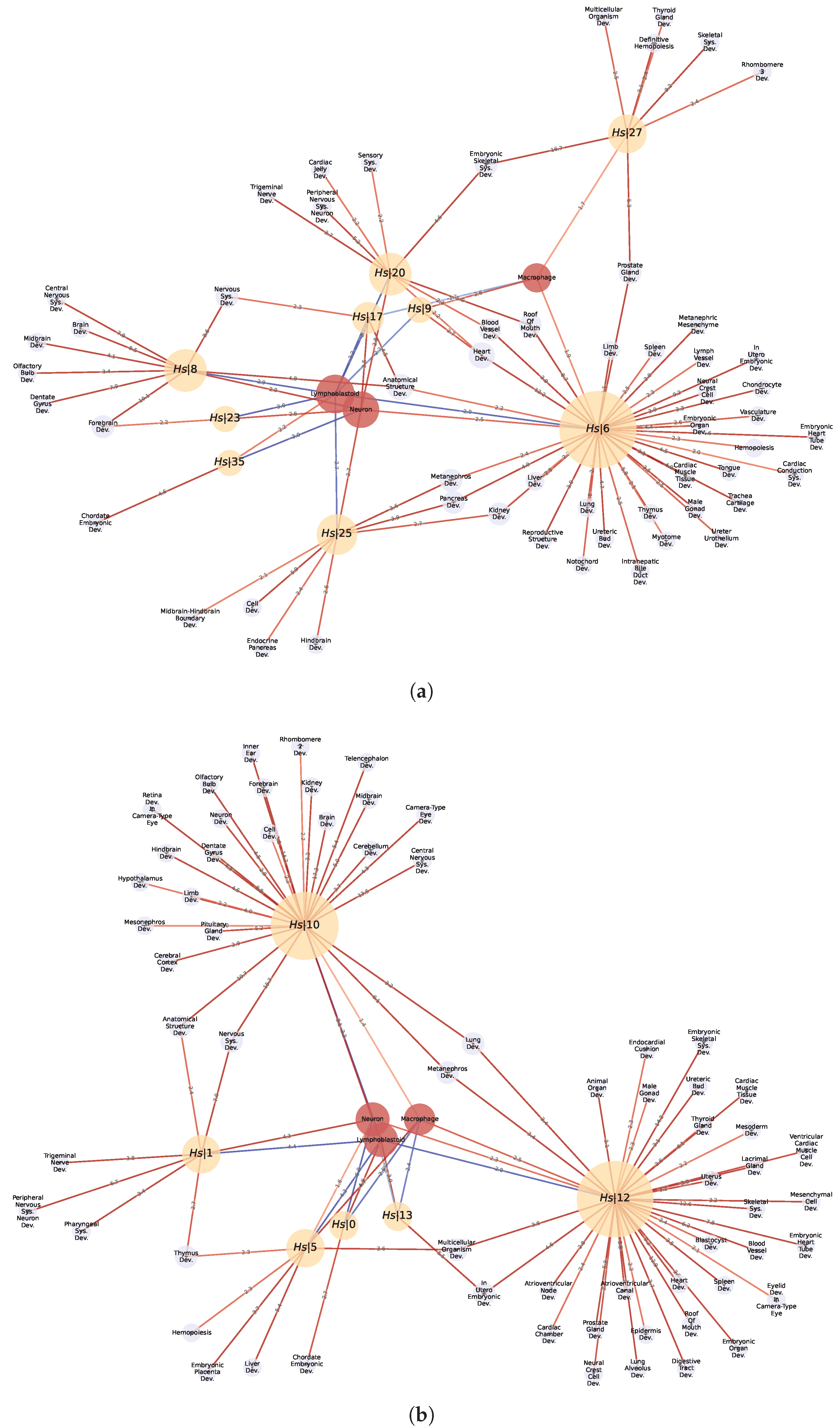
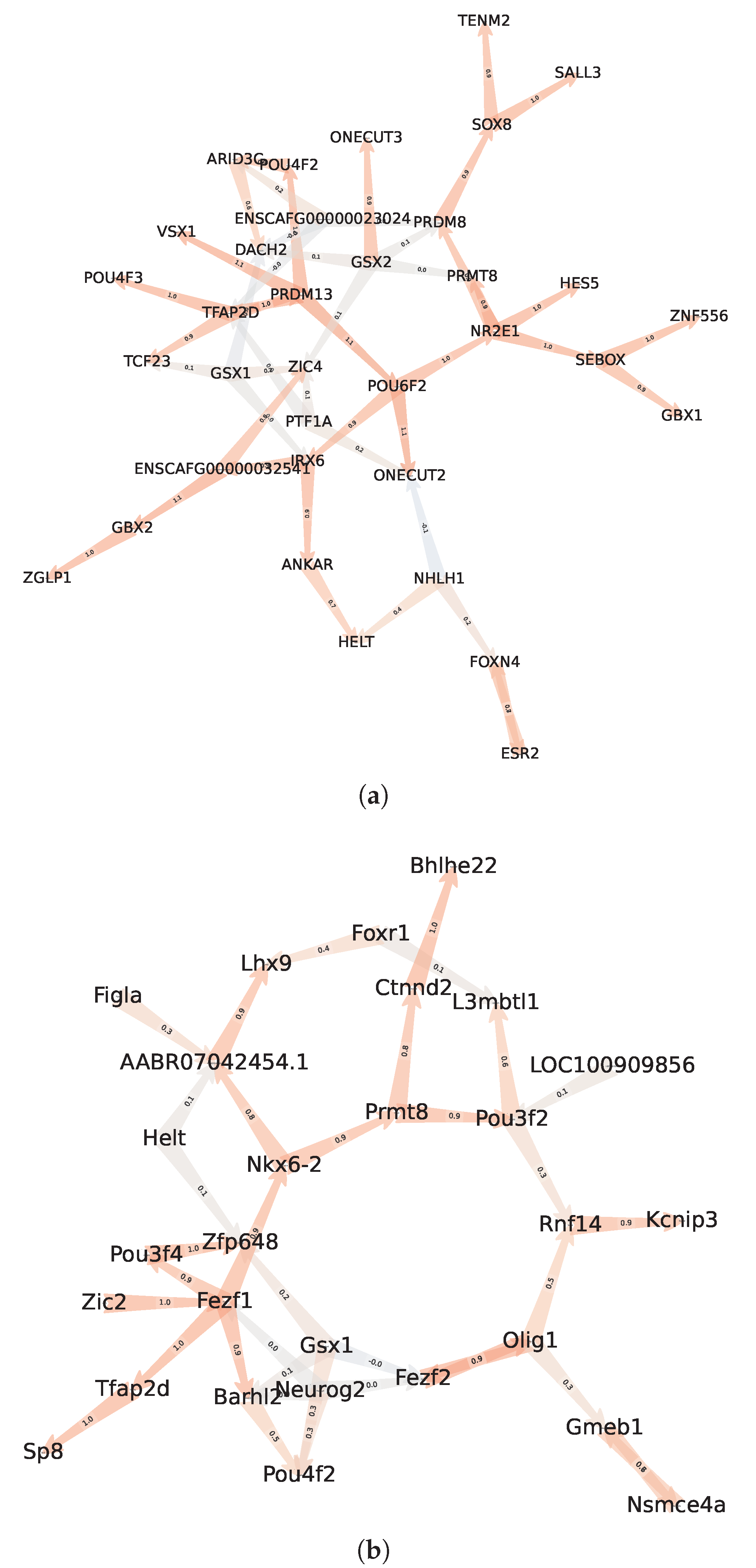
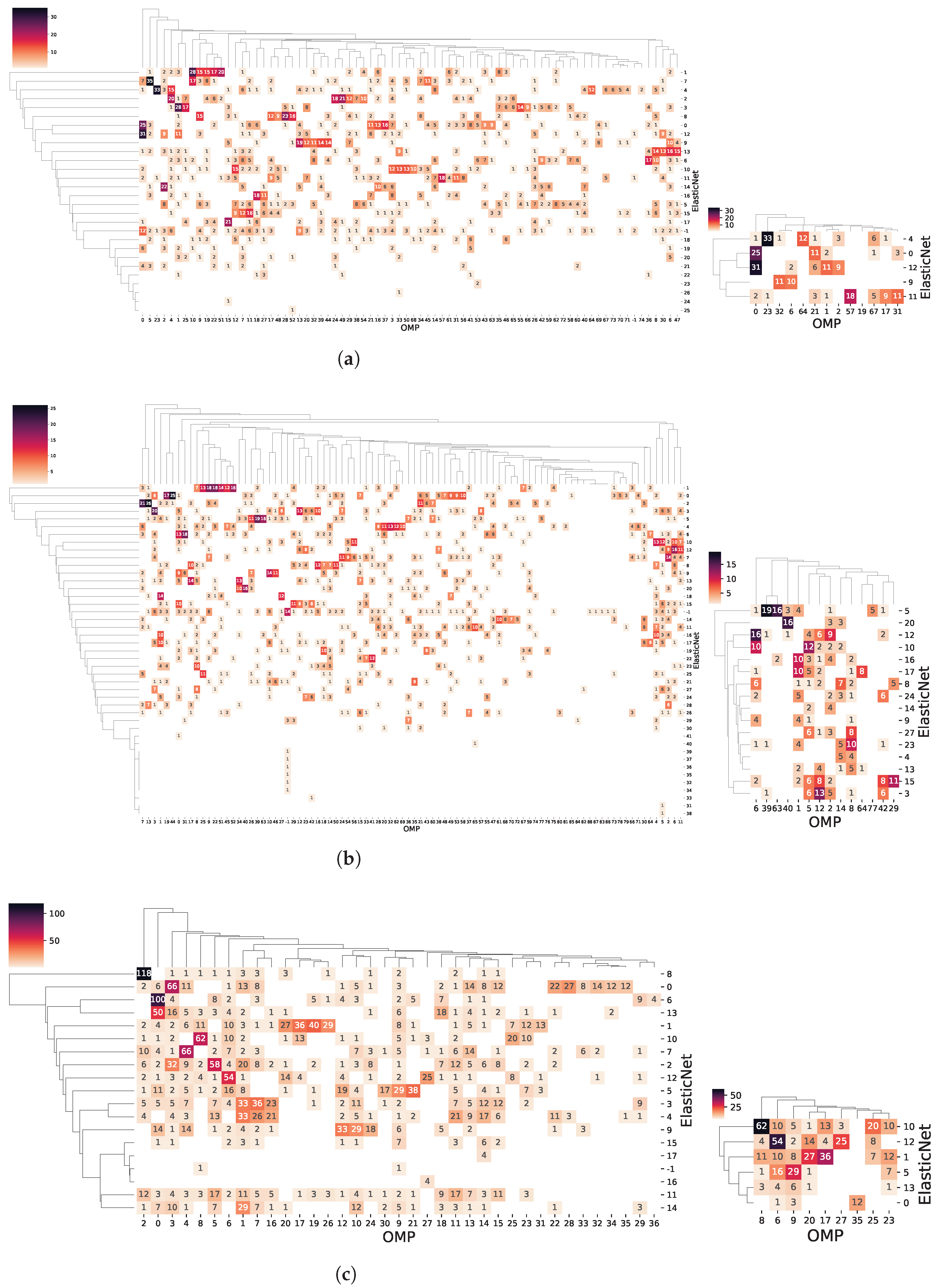

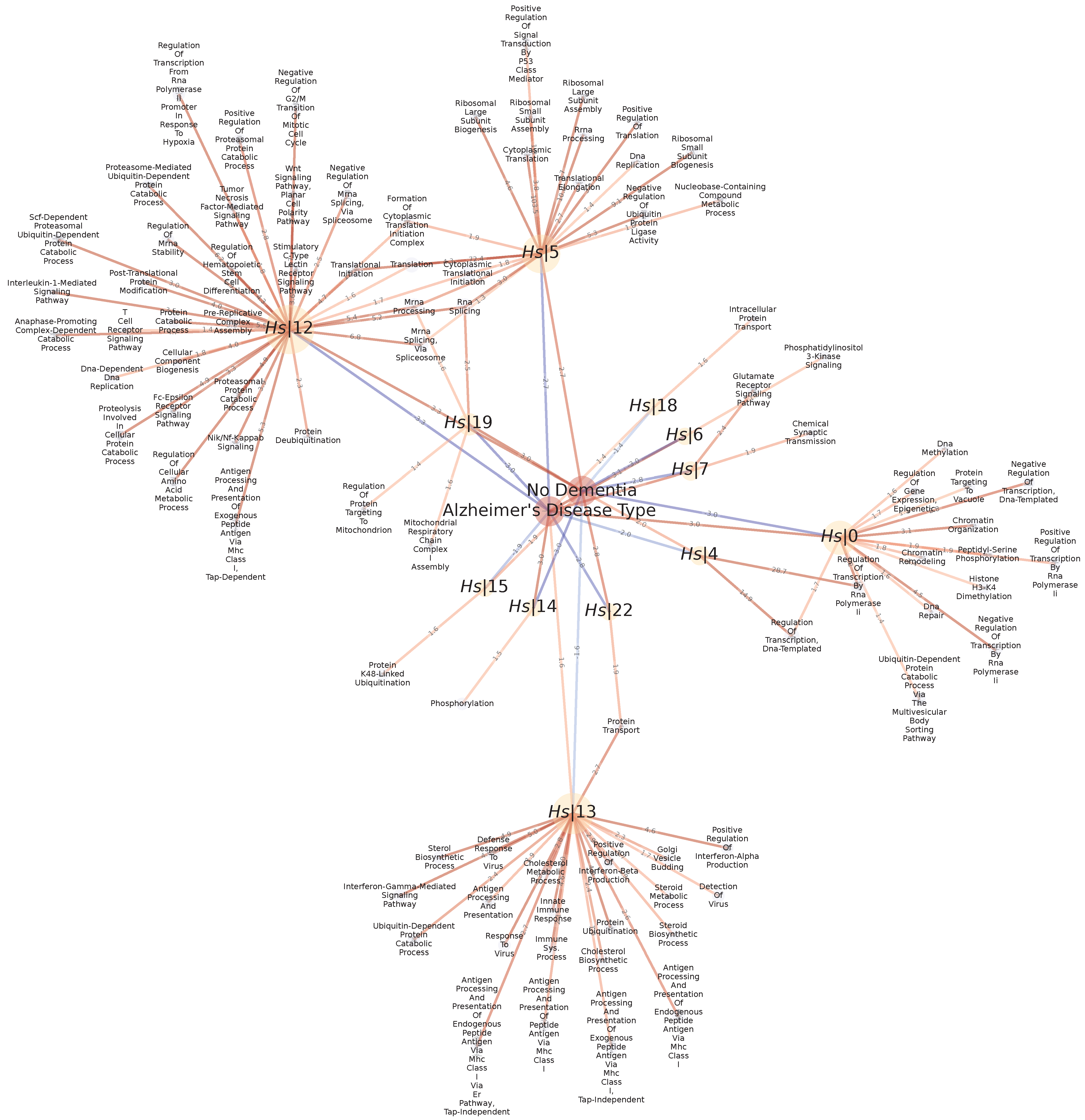
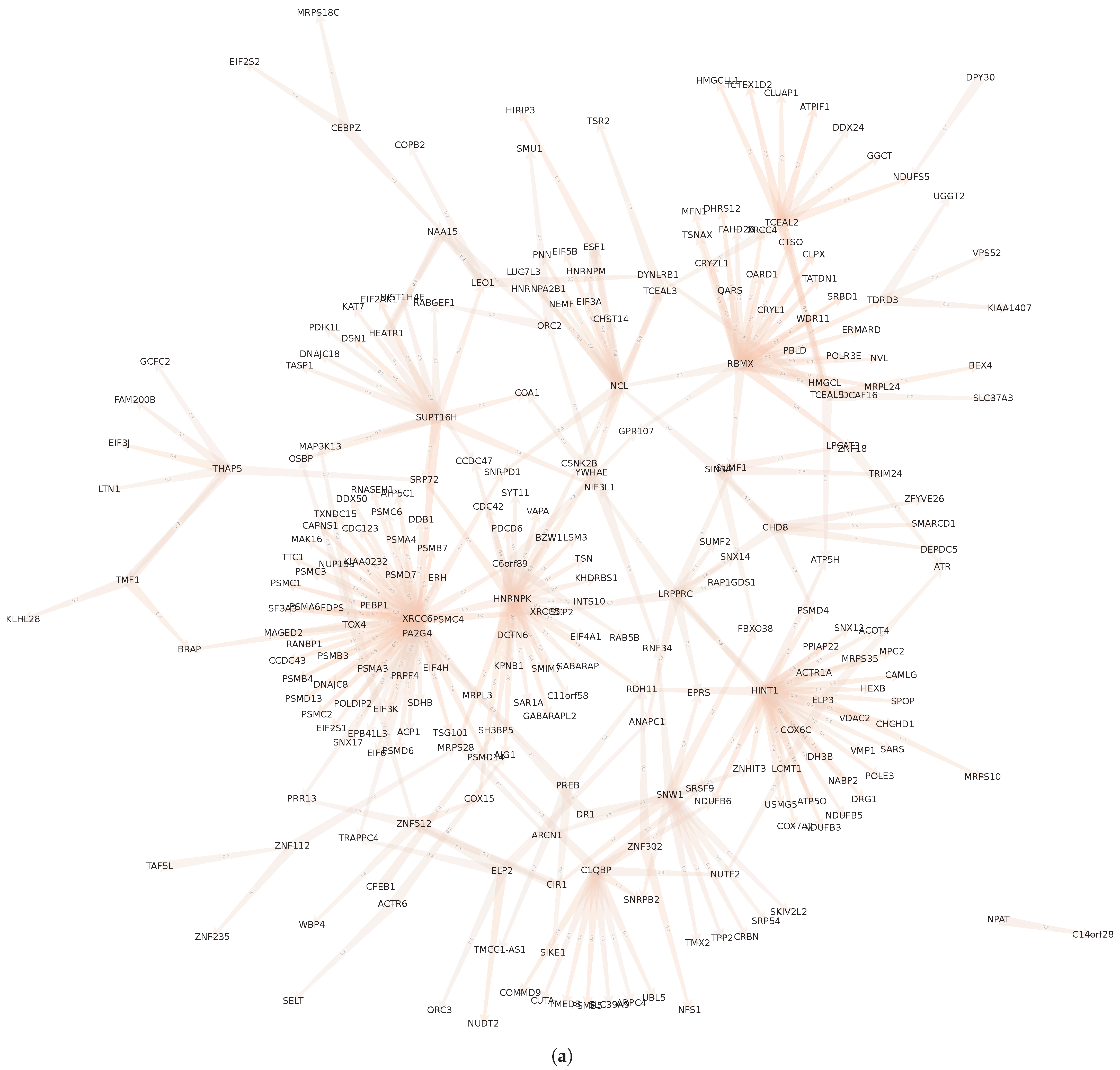
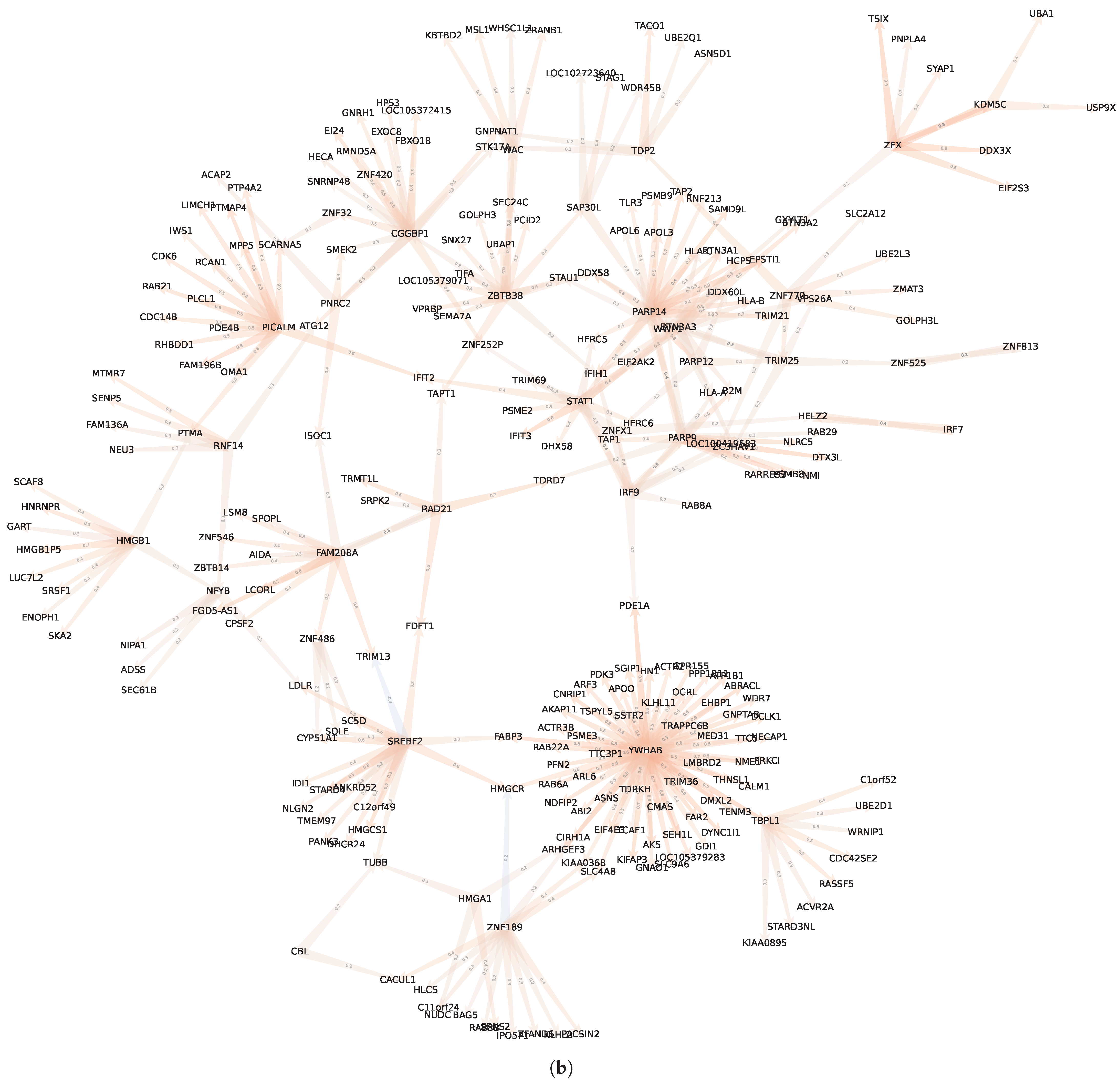
| DREAM5 | Data | D | |||||
|---|---|---|---|---|---|---|---|
| in silico | Simulated | 805 | 1643 | 195 | 4012 | 0.014 | 320,190 |
| S. aureus | Microarray | 160 | 2810 | 99 | 515 | 0.028 | 278,091 |
| E. coli | Microarray | 805 | 4511 | 334 | 2066 | 0.013 | 1,506,340 |
| S. cerevisiae | Microarray | 536 | 5950 | 333 | 3940 | 0.017 | 1,981,017 |
| Eukaryotes | Data | D | # Tissues | = | |||
| C. familiaris | RNA-seq | 75 | 6 | 2286 | 5,223,510 | ||
| R. norvegicus | RNA-seq | 80 | 11 | 2358 | 5,557,806 | ||
| H. sapiens | RNA-seq | 657 | 3 | 2454 | 6,019,662 | ||
| Control/Disease | Data | D | |||||
| H. sapiens—Brain Control/Alzheimer | RNA-seq | 377 | 17,574 | 1994 | 35,042,556 | ||
| S. cerevisiae | E. coli | S. aureus | In Silico | |
|---|---|---|---|---|
| 0.025% | 0.027% | 0.021% | 0.021% | |
| 0.036% | 0.002% | 0.002% | 0.019% | |
| GXN•OMP (Min) | 84.474% | 83.530% | 75.760% | 97.037% |
| GXN•OMP (Max) | 99.258% | 99.181% | 98.990% | 99.487% |
| GXN•EN (Min) | 79.119% | 69.949% | 67.240% | 86.456% |
| GXN•EN (Max) | 94.929% | 94.454% | 90.238% | 93.429% |
| Sparsity (%) | Modularity | |||
|---|---|---|---|---|
| GXN•EN | GXN•OMP | GXN•EN | GXN•OMP | |
| R. norvegicus | 99.495 | 99.39 | 0.575 | 0.829 |
| C. familiaris | 99.491 | 99.357 | 0.627 | 0.835 |
| H. sapiens | 99.538 | 99.087 | 0.658 | 0.573 |
| Community Alzheimer (−) Control (+) | Community Alzheimer (+) Control (−) | ||||
|---|---|---|---|---|---|
| TF() | AlzheimerLink | TF() | Alzheimer Link | ||
| XRCC6 | 52 | [77] | YWHAB | 63 | [78,79] |
| HINT1 | 34 | [80] | BTN3A3 | 31 | [81] |
| RBMX | 30 | - | PARP14 | 21 | [82] |
| HNRNPK | 30 | [83] | TRIM25 | 20 | [84] |
| CPEB1 | 27 | [85] | STAT1 | 20 | [86] |
| NCL | 18 | [87] | CGGBP1 | 19 | [88] |
| SRA1 | 17 | [89] | SREBF2 | 18 | [90] |
| SUPT16H | 17 | - | PARP9 | 17 | [91] |
| ACTR6 | 15 | [92] | ZBTB38 | 17 | [93] |
| SNW1 | 15 | [94] | PICALM | 17 | [95] |
Disclaimer/Publisher’s Note: The statements, opinions and data contained in all publications are solely those of the individual author(s) and contributor(s) and not of MDPI and/or the editor(s). MDPI and/or the editor(s) disclaim responsibility for any injury to people or property resulting from any ideas, methods, instructions or products referred to in the content. |
© 2023 by the authors. Licensee MDPI, Basel, Switzerland. This article is an open access article distributed under the terms and conditions of the Creative Commons Attribution (CC BY) license (https://creativecommons.org/licenses/by/4.0/).
Share and Cite
Peignier, S.; Calevro, F. Gene Self-Expressive Networks as a Generalization-Aware Tool to Model Gene Regulatory Networks. Biomolecules 2023, 13, 526. https://doi.org/10.3390/biom13030526
Peignier S, Calevro F. Gene Self-Expressive Networks as a Generalization-Aware Tool to Model Gene Regulatory Networks. Biomolecules. 2023; 13(3):526. https://doi.org/10.3390/biom13030526
Chicago/Turabian StylePeignier, Sergio, and Federica Calevro. 2023. "Gene Self-Expressive Networks as a Generalization-Aware Tool to Model Gene Regulatory Networks" Biomolecules 13, no. 3: 526. https://doi.org/10.3390/biom13030526
APA StylePeignier, S., & Calevro, F. (2023). Gene Self-Expressive Networks as a Generalization-Aware Tool to Model Gene Regulatory Networks. Biomolecules, 13(3), 526. https://doi.org/10.3390/biom13030526





